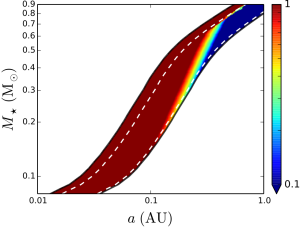In journal club on Friday, we discussed a fascinating paper that presented some problematic results for detecting life on other planets. Luger and Barnes (2014) looked at what could happen to the water on Earth-like planets orbiting many different kinds of stars.
Like the Sun, all stars produce x-rays and ultraviolet light (UV), but not all stars produce the same amount. In fact, stars much less massive than the Sun produce a lot more.
That’s a problem for life on planets orbiting these stars because x-rays and UV (collectively called XUV) can photodissociate (or break-up) water molecules in the atmosphere. Once the water is broken into hydrogen and oxygen atoms, the hydrogen can escape to space so the water is permanently lost, leaving behind the oxygen.
And this isn’t just a hypothetical scenario — Venus probably had oceans, like the Earth, and lost them this way. Of course, water is necessary for life as we know it, so a planet that loses its water can’t host life.
Luger and Barnes modeled this process and found that a lot of planets that might otherwise be suitable for life could actually lose a lot of water. The figure at left shows how much water could be lost for planets in the habitable zones of stars from about 0.1 to 0.9 solar masses (M⊙). The dark red region shows that most of the planets would actually lose at least 1 oceans-worth of water.
So not only would these planets be bone-dry, they could have a lot of oxygen in their atmospheres. On the Earth, oxygen is produced by photosynthetic planets and algae, and so its presence in a planet’s atmosphere is usually thought of as a smoking gun for life. If Luger and Barnes are right, their results may spell trouble for the search for life elsewhere in the universe.
